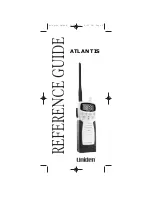
Install/Remove the Battery Pack
Install: Position the four grooves of the battery pack over the corresponding guides on the back of the transceiver. Slide the
battery pack upward the back of the transceiver until you feel a click and the battery is locked.
Remove: One hand holds the transceiver with battery pack facing outside of palm. The other hand push down the release
catch at the bottom of transceiver with thumb, and use fingers to hold and slide the pack away from the transceiver.
Install the Antenna
Hold and screw the antenna into the connector on the top of the transceiver.
Install the Speaker-Microphone
Use screwdriver to remove the cap from the speaker-microphone jack. Then plug the speaker-microphone in the jack.
Install the Belt-Clip
Use the 3mm
×
8mm screws from the supplied screw set to attach the belt-clip.
KNOWING THIS TRANSCEIVER
①
CHANNEL
selector
Selects operating channels. The channels need to be preset by your dealer.
②
POWER/VOLUME
control
Switches on/off the transceiver; you can hear a click. A beep can also be heard if the dealer programs it. Also adjusts the
transceiver volume.
③
LED
indicator
Lights red when transmitting. Flashes red when the battery voltage is low. Lights green when received a signal.
⑩
PTT (Push-to-Talk) switch
Hold down to talk and release to listen.
⑿
MONI
button
Hold down to monitor any signal even so weak that below the squelch level on your selected channel. You will hear the
background noises when held down.
Hold down to check and adjust the speaker volume.
Hold down to check the transceiver is working or not. If no noise coming out when pressed, that probably means low
battery, or the transceiver was turned off.
⒀
Speaker-Microphone jacks
To plug in the speaker-microphone pins here.
BASIC FUNCTIONS & FEATURES
Calling & Receiving
1. Press
[Moni]
and listen to make sure the channel is not being used.
2.
Hold the transceiver 3~4 cm (1 1/2 inches) from your lips, hold down
[PTT]
and speak in normal voice. The
LED
lights red while transmitting.
3.
Release the
PTT
button to return to the receiving mode.
CTCSS & DCS
If your dealer programmed
CTCSS
or
DCS
signaling for you and your group, you will hear your group
ONLY
without
interference from outsiders who work on the same frequencies. (But that does not mean your conversations are absolutely
private).
Time-Out Timer (TOT)
TOT
is a self-protection function to prevent continuous transmission over a long period of time that can overheat and harm
the transceiver. Transceiver would stop transmitting and generate a warning tone if
[PTT]
were held down
for longer than
the programmed time (preset as 60 seconds). Releasing
[PTT]
stops
the warning tone.
Busy Channel Lockout
Activated by your dealer, this function prevents the interference with others by prohibiting you from transmitting and
generating an audible warning tone while the selected channel is in use by others. Release
[PTT]
to cancel the alarm and

























